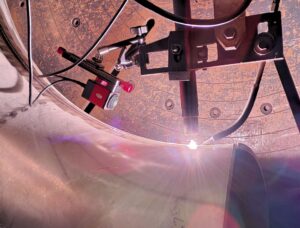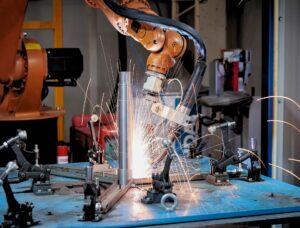Welding spatter is a common issue that affects weld quality and efficiency. These tiny molten metal droplets scatter around the work area, leading to poor aesthetics, increased cleanup time, and material waste. Spatter is especially common in MIG welding, flux-cored arc welding, and stick welding, but it can be minimized with proper technique, welding equipment, and a weld monitoring system. Using weld monitoring cameras and welding visual inspection techniques can help identify spatter causes in real time, ensuring cleaner, stronger welds. This guide explains the main reasons for welding spatter and how to reduce welding defects with proper settings and techniques.
Why Does Welding Spatter Occur?
Spatter can result from various welding problems, including incorrect voltage, wire feed speed, poor shielding gas selection, and contaminated materials. The most common causes include:
- Excessive Voltage or Amperage: Too much power creates an unstable arc, leading to metal droplets forming and scattering.
- Incorrect Wire Feed Speed: If the wire feed is too high, excessive material melts, causing spatter. Too low, and the arc becomes unstable.
- Poor Shielding Gas Selection: Improper MIG and MAG welding process gas mixtures can lead to oxidation and excessive spatter.
- Dirty or Contaminated Base Metal: Rust, grease, or paint on the surface disrupts the arc and increases spatter formation.
- Improper Welding Technique: Holding the torch at the wrong angle or moving too fast/slow can create inconsistent arc conditions.
A weld monitoring camera helps detect these issues early, improving weld inspection techniques and overall quality.
How to Minimize Welding Spatter
1. Adjust Voltage and Amperage Properly
- Use recommended voltage settings for your welding process to ensure a smooth, stable arc.
- If using MIG welding, adjust the amperage based on material thickness.
- Reduce excessive heat input to prevent unnecessary spatter formation.
Using a welding camera manufacturer’s monitoring system can help you fine-tune arc settings in real time.
2. Optimize Wire Feed Speed
- Set the wire feed speed correctly for the MIG welding process.
- Too fast? You’ll get excessive spatter due to too much metal melting at once.
- Too slow? The arc becomes erratic, leading to poor penetration and splatter.
A weld monitoring system provides real-time feedback to maintain the right wire speed.
3. Choose the Right Shielding Gas
- For MIG welding, a mix of argon and CO₂ minimizes spatter and improves arc stability.
- Avoid 100% CO₂, as it creates a hotter arc and more spatter.
- For TIG welding, use pure argon for a clean, precise arc.
Using proper welding gases is crucial for high-quality welds with minimal spatter.
4. Keep the Workpiece Clean
- Remove rust, grease, oil, and paint before welding.
- Use a wire brush or grinding tool to clean the surface.
- For aluminum welding, removethe oxide layer using a stainless steel brush.
Welding inspection techniques help detect contamination before starting the weld.
5. Improve Welding Technique
- Hold the welding torch at the correct angle (typically 10-15 degrees for MIG welding).
- Maintain a steady hand movement to avoid erratic arcs.
- Avoid pushing the wire into the weld pool too aggressively.
A welding camera helps refine technique by providing high-resolution arc welding images.
6. Use Anti-Spatter Spray and Proper Nozzle Maintenance
- Apply an anti-spatter spray to reduce buildup on nozzles and workpieces.
- Keep welding nozzles and contact tips clean to ensure smooth gas flow.
- Replace worn-out contact tips to maintain stable arc performance.
Regular maintenance of welding equipment prevents excessive spatter formation.
How Weld Monitoring Systems Improve Spatter Control
Using welding technology like a weld monitoring system can greatly enhance welding quality and efficiency.
- Real-time Arc Welding Image Analysis: Monitors arc behavior and detects inconsistencies.
- Weld Inspection for Defects: Identifies early signs of slag inclusion, porosity, and poor penetration.
- Process Optimization: Helps adjust voltage, wire feed speed, and shielding gas settings for cleaner welds.
A welding camera ensures high-quality welds with minimal spatter and defects.
Conclusion: Achieve Cleaner, Stronger Welds
Understanding spatter causes and solutions can help you achieve cleaner, stronger, and more efficient welds. By adjusting voltage, optimizing wire speed, choosing the right shielding gas, and refining your technique, you can significantly reduce spatter and weld problems.
Using advanced welding inspection techniques like a welding camera and weld monitoring system ensures consistent weld quality and reduces defects.
Mecaweld’s weld monitoring cameras provide real-time insights to improve welding technology and efficiency. Contact us today to learn more about our innovative welding inspection solutions!



